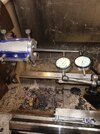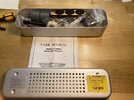Barrel : Winchester 69 22 lr
Goal : 11 degree target crown
22 LR PTG range rod is being used for indicator surface.
So I have never used a spider before so this is all Greek.
I can make one indicator run perfectly 0 while the the other indicator runs .030 to .050 inch out.
When I adjust the second set of bolts the zeroed indicator loses its 0.
So I go back and forth and nothing is done.
How do I do this and what am I doing wrong?
When I get this figured out I will use test indicators

Goal : 11 degree target crown
22 LR PTG range rod is being used for indicator surface.
So I have never used a spider before so this is all Greek.
I can make one indicator run perfectly 0 while the the other indicator runs .030 to .050 inch out.
When I adjust the second set of bolts the zeroed indicator loses its 0.
So I go back and forth and nothing is done.
How do I do this and what am I doing wrong?
When I get this figured out I will use test indicators




